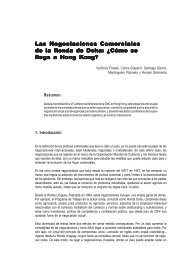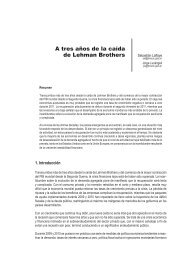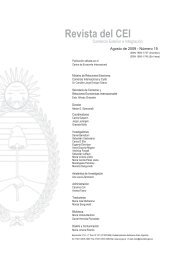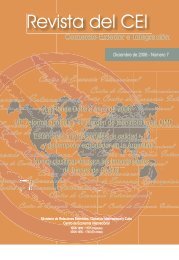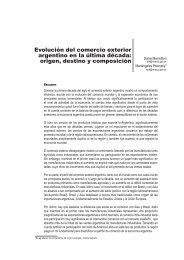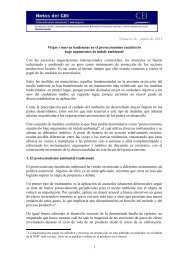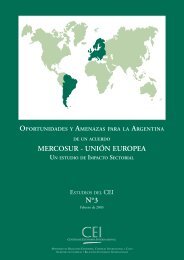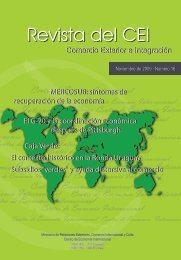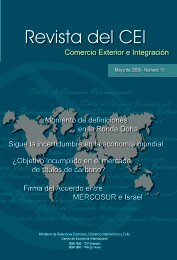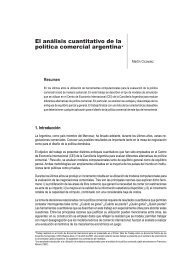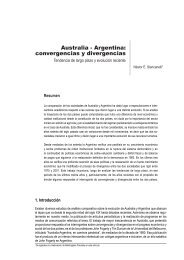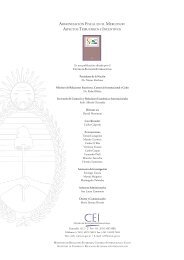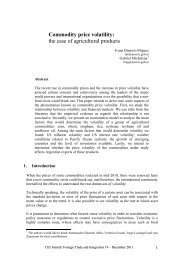science and technology. The last estimates for 2006 confirm this assumption hinting at a 26% increase intax revenues, which substantially overtakes the nominal growth in GDP.Regarding the Fe<strong>de</strong>ral Budget execution, Australia has had surplus since 1996 to date, which allowed fora substantial reduction in government <strong>de</strong>bt (Table 4).This was not the case for Argentina, which has seen high levels of budgetary <strong>de</strong>ficit since then and until2001. Such <strong>de</strong>ficits were financed by means of increasing foreign public <strong>de</strong>bt. Consi<strong>de</strong>ring only the years2000 and 2001, fiscal imbalances of US$ 6,049 and US$ 10,729 million are found in the national budget.These amount to 2.1% and 4.0% of GDP, respectively, to which provincial budget imbalances of around2% of GDP should be ad<strong>de</strong>d. The greater risk arising from an important public <strong>de</strong>bt accumulation 3 gaverise to a <strong>de</strong>pletion of voluntary funding sources and, subsequently, to the suspension of payments by theCentral Administration, which en<strong>de</strong>d in the <strong>de</strong>bt crisis at the end of 2001.As a result of the economic policy change and the strong fiscal adjustment already mentioned, the budget<strong>de</strong>ficit plummeted dramatically to just US$ 618 million in 2002 and changed into a surplus of more than3% of GDP from 2003 onwards. The surplus thus obtained ma<strong>de</strong> it possible to reschedule the foreignpublic <strong>de</strong>bt, to start repaying the <strong>de</strong>bt service and increasing the investment component in the publicbudget.Table 4Australia and Argentina. Fe<strong>de</strong>ral Budget Executionmillion US dollarsAustraliaArgentinaYear Revenue Expenses Balance Revenue Expenses Balance2000 101,715 96,020 5,695 43,189 49,238 -6,0492001 84,285 83,508 777 37,176 47,905 -10,7292002 96,441 98,503 -2,062 14,403 15,021 -6182003 122,574 121,645 929 19,244 18,935 3092004 132,767 130,606 2,161 24,363 21,425 2,9382005 161,165 158,797 2,368 29,311 25,992 3,319Source: Reserve Bank of Australia and Public Budget Secretariat, Ministry of Economy and Production of Argentina.3. EmploymentAt the end of 2005, the Australian unemployment rate was 5.2%. In Argentina, counting welfare recipientsas employed workers, this rate was 10.1%. Excluding the latter, the rate was 12.7% of the workforce.Unemployment has <strong>de</strong>creased steadily in Australia since 1990-91, when it was 10.9%, a figure similar tothe current one for Argentina. A floating exchange rate, mo<strong>de</strong>rate interest and inflation rates, and threeyearemployment contracts facilitated the domestic economy’s adjustment to the variable conditions of theinternational economy, which has gone through subsequent crises over the past fifteen years. Theparticular case of Asia in 1997-98 is especially worthy of note, since it represents the natural market for3 It had to be calculated in foreign currency due to the currency board in place from 1991 until 2001, when there wasa peso-US dollar exchange parity.
Australia by virtue of its geographical proximity, in addition to the dimension and dynamism of its <strong>de</strong>mand.The impact of the Asian recession was not as serious as had first been feared, probably due to currencyfloating and the US economic expansion, absorbing more Australian exports, as well as the privilegedfiscal position, which enabled the Australian fe<strong>de</strong>ral government to implement counter-cyclical policiesexpanding public expenditure until the crisis was overcome. As from the present <strong>de</strong>ca<strong>de</strong>, the stronggrowth of China and other Asian countries encouraged investment in mining and energy resources, whichresulted in an increase in production and exports. It also stimulated educational services exports,traditionally addressed to that continent. The low interest rates, abundance of liquidity and incentives toinvestment in real estate meant an unremitting dynamism for the construction sector which, together withthe remaining factors, allowed for an increase in consumption and investment <strong>de</strong>mand and, therefore, inlabour <strong>de</strong>mand.In Argentina, the unemployment rate, traditionally within one digit, sud<strong>de</strong>nly soared from 6% in 1991 to12.1% in 1994 and 18.1% in 2001. The one-to-one peso to US dollar peg, adopted by a convertibilitystatute enacted in 1991, was in place during a period when the United States currency showed asignificant appreciation. Consequently, it resulted in a loss of competitiveness of the economy andhin<strong>de</strong>red the adjustment to the changeable conditions present in the international scenario, such as thecrises in Mexico and Asia in 1995 and 1997, respectively, and the strong currency <strong>de</strong>valuation in Brazil(the country’s main tra<strong>de</strong> partner) in 1998. As a result, there was an increase in fiscal and balance ofpayments <strong>de</strong>ficits, foreign <strong>de</strong>bt and interest rates due to a higher country risk and <strong>de</strong>clining economicactivity. Therefore, it is not surprising that the highest unemployment peak was observed in 2001, with theexplosion of the economic, social and institutional crisis, characterised as one of the worst the country hasever suffered.The strong <strong>de</strong>valuation of the peso, fiscal discipline, monetary expansion and temporary suspension ofpublic <strong>de</strong>bt payments in 2002 ma<strong>de</strong> it possible to gradually reverse the drastic plunge in the GDP. As hasbeen pointed out, strong growth rates in output and services have arisen since 2003, which, together withthe budgetary consolidation, higher expenditure in investment, and <strong>de</strong>bt refinancing have produced theconditions necessary to create jobs and reduce the unemployment rate, which by the end 2006 couldreturn to the single-digit level.When assessing the unemployment level, an important aspect to bear in mind is one connected with thestability of the Australian participation rate, traditionally much higher than that of Argentina, together withthe substantial increase in the Argentine rate since 2001 onwards. The latter indicates that an increase inlabour <strong>de</strong>mand gradually stimulates a higher supply, attracting people who previously had no expectationsand were outsi<strong>de</strong> the labour market (Table 5).
- Page 1 and 2:
Revista del CEIComercio Exterior e
- Page 3:
SUMARIOCOYUNTURA COMERCIALEstructur
- Page 7 and 8:
PresentaciónLa sección de coyuntu
- Page 13 and 14:
G r á f i c o 3Diversificación de
- Page 15 and 16:
Las exportaciones de productos prim
- Page 17 and 18:
Relacionado con la evolución que v
- Page 19 and 20:
Vinculado al fuerte crecimiento que
- Page 21 and 22:
Este efecto fue revertido principal
- Page 23 and 24:
Aun así, merecen destacarse al men
- Page 25 and 26:
Cuadro A 1Evolución del saldo de b
- Page 28 and 29:
Cuadro A 4Exportaciones e índice d
- Page 30 and 31:
Cuadro A 6Saldo de balanza comercia
- Page 32 and 33:
las exportaciones en concepto de vi
- Page 34 and 35:
G r á f i c o 3Valor y cambio abso
- Page 36 and 37:
como lo son Egipto, Nigeria, Venezu
- Page 38 and 39:
G r á f i c o 2Crecimiento de las
- Page 40 and 41:
El total exportado también se encu
- Page 42 and 43:
Del Cuadro 1 se desprende una asoci
- Page 44 and 45:
En el primer semestre del año, el
- Page 46 and 47:
Vehículos de navegación aérea, m
- Page 48 and 49:
Unidos. En todos los casos menciona
- Page 50 and 51:
BibliografíaCastagnino, T. (2006).
- Page 52 and 53:
Cuadro A 2G R Á F I C O 1:Exportac
- Page 54 and 55:
Cuadro A 4Exportaciones e índice d
- Page 56 and 57:
Cuadro A 6Saldo de balanza comercia
- Page 58 and 59:
las exportaciones en concepto de vi
- Page 60 and 61:
G r á f i c o 3Valor y cambio abso
- Page 62 and 63:
Se mantiene eldinamismo del BloqueH
- Page 64 and 65:
vez como miembro pleno, en junio tu
- Page 66 and 67:
en el primer semestre del año.Las
- Page 68 and 69:
septiembre del año pasado un baja
- Page 70 and 71:
considera que al cierre del año la
- Page 72 and 73:
dólares norteamericanos, asciende
- Page 74 and 75:
Ambición y equilibrioen la Ronda D
- Page 76 and 77:
3. Resultados mínimos de las conce
- Page 78 and 79:
La aplicación de la propuesta menc
- Page 80 and 81:
4. La ambición y el equilibrio nec
- Page 82 and 83:
El ingreso deVenezuela al Mercosur:
- Page 84 and 85:
A 2006 la estructura arancelaria vi
- Page 86 and 87:
En principio la Argentina participa
- Page 88 and 89:
hubieron otros donde la participaci
- Page 90 and 91:
se puede establecer, según datos d
- Page 92 and 93:
La otra metodología que se utiliza
- Page 94 and 95:
Asimismo, reconoce que la prestaci
- Page 96 and 97:
problema debido a que en el Anexo D
- Page 98 and 99:
Según lo observado en los procesos
- Page 100 and 101:
Trade Facilitation:Definitions, WTO
- Page 102 and 103:
se puede establecer, según datos d
- Page 104 and 105:
La otra metodología que se utiliza
- Page 106 and 107:
Asimismo, reconoce que la prestaci
- Page 108 and 109: problema debido a que en el Anexo D
- Page 110 and 111: Según lo observado en los procesos
- Page 112 and 113: Australia - Argentina:convergencias
- Page 114 and 115: Artículosde 2002 en adelante, por
- Page 116 and 117: Artículosaustraliano), para la rat
- Page 118 and 119: Artículosimportantes inversiones y
- Page 120 and 121: Artículossociales de carácter mod
- Page 122 and 123: Artículospagos de la Administraci
- Page 124 and 125: Artículosmayor libertad de acción
- Page 126 and 127: ArtículosLa disminución del peso
- Page 128 and 129: Artículospor 6.490 millones de dó
- Page 130 and 131: ArtículosLos datos anteriores evid
- Page 132 and 133: ArtículosAustralia a Canberra en 1
- Page 134 and 135: Artículossentaron el 25,0% del tot
- Page 136 and 137: ArtículosBibliografíaAustralian B
- Page 138 and 139: El análisis cuantitativo de lapol
- Page 140 and 141: ArtículosSimulacionesLa metodolog
- Page 142 and 143: Artículoscomo así también insumo
- Page 144 and 145: Artículosdiante la matriz inversa
- Page 146 and 147: ArtículosLas estimaciones realizad
- Page 148 and 149: SummaryAustralia - Argentina:Conver
- Page 150 and 151: evealed by growing political and cu
- Page 152 and 153: Governor-General proposing the pers
- Page 154 and 155: enabled a symmetrical growth in the
- Page 156 and 157: 3. Recent EvolutionThe information,
- Page 160 and 161: Table 5Employment and Unemploymentp
- Page 162 and 163: Table 7High Human Development Index
- Page 164 and 165: It can be stated that Australia has
- Page 166 and 167: 3. Balance of Payments and Foreign
- Page 168 and 169: end of 2006. For the very first tim
- Page 170 and 171: Budget surplus has a counter-cyclic
- Page 172 and 173: plantations, food industries, cold
- Page 174 and 175: The One Thousand Faces ofAgricultur
- Page 176 and 177: A fines de la década de los 50, cu
- Page 178 and 179: estratégicos que efectúan los pa
- Page 180 and 181: subsidios (es más, sólo el 5 por
- Page 182 and 183: de exportar aeronaves y de no afron
- Page 184 and 185: deberíamos suponer que habría una
- Page 186 and 187: tienen jerarquía de tratado intern
- Page 188 and 189: Con el establecimiento de la OMC se
- Page 190 and 191: 3. Para completar el tercer aspecto
- Page 192 and 193: 5 Anexo
- Page 194 and 195: AnexoPIB a precios y tipos de cambi
- Page 196 and 197: AnexoSaldo de la Cuenta Corrienteen
- Page 198 and 199: AnexoTasas de Desempleopromedio anu
- Page 200 and 201: AnexoTasas de inflación (Precios M



